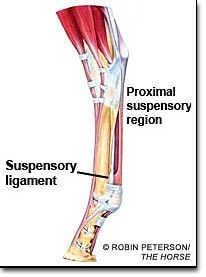The Photographic Wedge Study
Farrier Wisdom and Medical Index



Suspensory Ligament Proximal
What is suspensory desmitis (DSLD)? "Degenerative Suspensory Ligament Desmitis commonly called DSLD, also known as Equine Systemic Proteoglycan Accumulation (ESPA) is a systemic disease of the connective tissue of the horse and other equines. It is a disorder akin to Ehlers-Danlos syndrome ![]() now being researched in multiple horse breeds. Originally thought to be a condition of overwork and old age, the disease is now recognized as hereditary and has been seen in horses of all ages, including foals. The latest research has led to the proposed renaming of the disease from DSLD to ESPA because of the systemic and hereditary components now being found.
now being researched in multiple horse breeds. Originally thought to be a condition of overwork and old age, the disease is now recognized as hereditary and has been seen in horses of all ages, including foals. The latest research has led to the proposed renaming of the disease from DSLD to ESPA because of the systemic and hereditary components now being found.
It has been found in many horse breeds, including Arabians, Thoroughbreds, American Quarter Horses, Morgans, Peruvian Pasos, Paso Finos, American Saddlebreds, several breeds of warmblood, Appaloosas, Friesian, Missouri Fox Trotters, Tennessee Walkers, Paints, National Show Horses, and Mustangs, as well as crossbreds and mules.
DSLD was once considered a condition of the legs only, as one of the most visible signs is when the fetlocks, particularly on the hind legs, collapse into a 'coon-footed' position. However, microscopic examination in necropsy has shown DSLD/ESPA horses can be affected not only in the tendons and ligaments of all legs and the patella, but can have affected tissues in the nuchal ligament, eyes, aorta, skin and fascia, lungs and other organs, as well as ligaments and tendons throughout the body. Because of its systemic nature, and because connective tissue is present everywhere in a biological entity, the entire body becomes affected in multiple ways as the disease progresses. Some horses have shown an iron overload in the liver as well.
Ongoing research is working on the biochemical aspects of the disease and has found a problem in the transfer growth factor and decorin. It is strongly believed to be passed genetically, and those aspects are being studied in the search for a DNA marker. Research is continuing, and much is yet to be learned." ![]() DSLD
DSLD
"In many cases of chronic persistent suspensory desmitis we elect to conduct a static wedge study of the affected limb(s) with the intention of determining the most appropriate hoof (palmar or plantar) angle for the horse. In most cases, an angle which positions the fetlock joint as far cranial as possible relative the toe of the foot is desirable. In this position, we would expect minimal static tension experienced by the suspensory apparatus. Moreover, we would anticipate accelerated breakover of the limb dynamically (during movement), which would also keep suspensory ligament tension at a minimum.
Here's the protocol:
1) Acquire a photographic image of the subject foot (lateral view, no wedge) at ground level. Use a measuring device (such as a ruler) to calculate the distance between the ground surface and a specific piece of anatomy at fetlock level (such as the ergot, color border or feather of hair).
2) Acquire a second photographic image of the subject foot (lateral view, with a wedge) at ground level. The horse's foot and camera should both be positioned as close to their original placement as possible. Calculate the distance between the ground surface and your anatomic marker in the same fashion as was previously completed.
3) Repeat the process as necessary using different degree wedged pads placed under the horse's heel and/ or toe.

4) Review your calculations in combination with the limb's general appearance (e.g. palmar/plantar angle, pastern axis, etc.) in each scenario to determine the most appropriate trimming/ shoeing package for the horse. Note that in many cases the desired angle can be achieved via corrective trimming alone and may not necessitate artificial wedge or shoe application.
Finally (and most importantly), we consult with the farrier for his/ her opinion since he/ she would have the most experience working with the horse's feet."
For More Information:
Proximal Suspensory Ligament Disease of the Forelimb